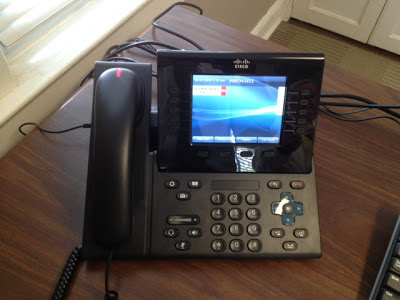At first glance, there's nothing unusual pictured on the desk above. There's a computer screen with a keyboard and mouse, and a phone as well. Look a little bit closer and you might observe the phone seems a bit different than other phones as school. But all in all, the set-up seems ordinary in our work environment.
The truth, however, is that this picture represents a major change in our network.
Since the onset of computers at GSB in the mid-1980's, all computing, whether on PCs or Macs, has been done on stand-alone machines. In other words, the CPU (central processor unit) has been housed in each unit. Each device was capable of independent computing. By the 1990's, these independent computers were linked together in a network but still, each device was capable of independent computing.
Now, in the business offices of Henshaw Building, desktop computers have been replaced by Thin Clients. That's a thin client device pictured above. So what's the difference?
Our thin client stations have no CPUs. Rather, they link to software that is being run on the server in Hockenbury. What a user will see on the monitor screen is identical to what he or she would see if using a computer, but all software is housed on the server. The whole approach to computing is called virtualization. Our Business Department is now working in a virtualized environment.
In our set-up, it's the phone that houses the thin client hardware. Yes, it still functions as any other phone in our system. But this device also houses the components for our virtualized system. The back of the phone shows that users still have the capability to connect USB-supported hardware and connect to external monitors. The picture below shows the back of the phone.
Why implement virtualization? Are there advantages? The answer is that there are several advantages, and each is significant. The cost of each thin client work station is cheaper than the equivalent purchase of a stand-alone computer. Additionally, they use less energy and break down far less frequently. They have no moving parts, so there's no fan and therefore no noise. They have a life expectancy of about 7-8 years, versus 3-4 years for a computer. Because the software is housed on our server, upgrades and installs can be done once in a planned, efficient way. Users can still log in to their account from any work station, but the load time will be quicker. Thin clients can run the same software that computers run. They can access the internet. But without an attached optical disc drive, they cannot play CDs or DVDs.
It's easy to see that virtualization offers considerable advantages over traditional computers. But configuring for virtualization was no easy task. Credit Ryan Roque for his tireless efforts to see the project through to completion.
Admittedly, this is a quick overview of virtualization. A quick web search will give you plenty of additional information if you are interested. But my intent is simply to let readers know that our school's computing environment is in transition, and moving forward, we'll being seeing an increased presence of virtualization on campus. The end result will be a mixed environment with both computers and thin clients in evidence throughout campus.





